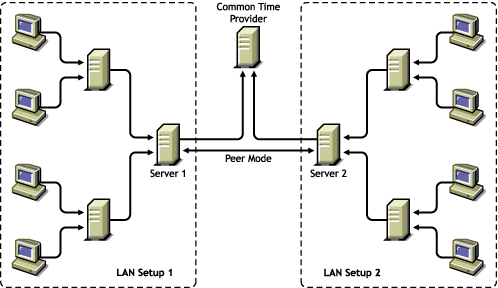4.3 Wide Area Configuration
Wide area configuration is best suited for setups where the servers are spread across geographical locations. It is also suitable for setups that need fault tolerance.
Wide area configuration can be achieved by completing the following tasks:
4.3.1 Planning the Setup
Create a plan for configuring the time provider group, which is a set of servers configured to ensure fault tolerance and optimal network usage.
4.3.2 Configuring the Time Provider Group
A time provider group consists of a set of servers that synchronize time in a fault tolerance setup and minimize network traffic.
Setting Fault Tolerance
-
Configure at least two servers to communicate with each other in the peer-to-peer mode by adding a line similar to the following to each server's ntp.conf file:
peer IP_address_of_peer -
Configure the servers to contact their own unique external time sources in the client-server mode by adding a line similar to the following to each server's ntp.conf file:
server IP_address_of_own_external_time_sourceIf one external time source link goes down, both time providers do not lose time synchronization.
-
Configure the servers to fall back to their local clocks (self-synchronize) and ensure that the external time source gets preference over the local clock. To achieve this, use a lower preference for the local clock (stratum value of 3). Add lines similar to the following to each server's ntp.conf file:
server 127.127.1.0
fudge 127.127.1.0 stratum 3
NOTE:It is recommended to use a higher value (maximum 16) for local clocks.
Minimizing Network Traffic
To minimize network traffic, configure two servers, on either side of the network, in either the peer-to-peer mode or the client-server mode. These two servers can either have their own external sources or be self-synchronized.
For more information, see Section 3.2, Peer-to-Peer Mode and Section 3.1, Client-Server Mode.
4.3.3 Configuring the Time Consumers
Setting Fault Tolerance
To set fault tolerance, configure all the time consumers to have at least two time providers either in the client-server mode or the broadcast/multicast mode.
For more information, see Section 3.1, Client-Server Mode and Section 3.3, Broadcast and Multicast Mode.
Minimizing Network Traffic
To minimize network traffic, time consumers should not contact the time providers that are across costly WANs. Preferably, a time consumer should contact a time provider within its own local network.
You can use either manual configuration or auto configuration to configure a time consumer.
To use manual configuration, add lines similar to the following to each time consumer's ntp.conf file:
server IP_address_of_time_provider1_within_same_network
server IP_address_of_time_provider2_within_same_network
or
To use auto configuration, add lines similar to the following to each time consumer's ntp.conf file:
broadcastclient subnet_broadcast_address
or
multicastclient
4.3.4 Sample Scenario
The sample scenario in the following figure demonstrates how to configure a setup using wide area configuration.
Figure 4-5 Sample Scenario for Wide Area Configuration

In this scenario:
-
There are two LAN setups. The time consumers and time providers in both the setups are synchronized for time.
Refer to Section 4.1, Manual Configuration and Section 4.2, Auto Configuration for more information.
-
In both LAN setups, only Server1 and Server2 obtain time from sources outside the local network.
-
Server1 and Server2 are time consumers that do the following:
-
First, obtain time from a common time provider in the client-server mode.
-
Second, obtain time from each other in the peer mode.
-
Third, fall back to their local clock if the external time sources fail.
-
To use auto configuration to configure the setup in this scenario:
-
Configure Server1 to obtain time from the common time provider in the client-server mode and make this the preferred time provider by adding a line similar to the following to Server1's ntp.conf file:
server IP_address_of_Common_Time_Provider prefer -
Configure Server1 to obtain time from its peer, Server2 in the peer mode.
peer IP_address_of_Server2 -
Configure Server1 to fall back to its own local clock. Set a low stratum value for the local clock so that preference is given to the external time sources. By setting a low stratum value, it falls back to its local clock only when the other sources fail.
server 127.127.1.0
fudge 127.127.1.0 stratum 3
-
Load XNTPD for the changes to take effect by entering the following at command prompt:
Load XNTPD -
Repeat this procedure, with the appropriate changes to Server2's ntp.conf file, to configure Server2.
You are minimizing network traffic by configuring only Server1 and Server2 to obtain time from a time provider outside the local network.